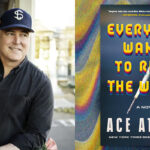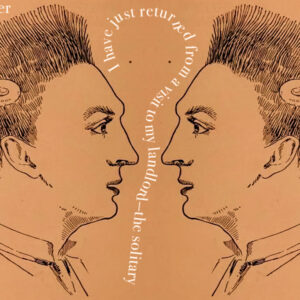
Talking to I Love Dick Co-Creator Sarah Gubbins
On Collaboration, Spontaneity, and Overcoming Your Own Self-Censor
Last week, Amazon launched its latest series, I Love Dick, amidst an overwhelming burst of internet publicity: fanfare, reviews, think pieces, interviews, essays. The show, co-created by Jill Soloway and Sarah Gubbins, is adapted from Chris Kraus’s book of the same title, originally published in 1997—a “singular cult novel” according to The New Yorker’s Alexandra Schwartz.
Playwright Sarah Gubbins stands out as a relatively fresh face alongside some of the project’s big Hollywood names, like Soloway, Kevin Bacon, Kathryn Hahn, and Griffith Dunne. Gubbins was in LA for a day, just before a trip to Italy with her mom, and she agreed to met up at Kismet on the east side of town. After we sat down and looked at the menu, she said: “I’m going to leave you in charge of ordering.”
Peter Nowogrodzki: Where are you from? And how did you come to be involved with I Love Dick?
Sarah Gubbins: Chicago, where I lived until about three and half years ago. I did theatre there—I come from a playwriting background. Then I moved out here.
And the short version of the TV show I Love Dick, starts with my collaboration with Jill Soloway, which began about six or seven months before I ever read the book I Love Dick. Jill and I share an agent, and she was looking for a co-writer on a feature film that she’s going to direct next year called “Ten Acre Wood.” So we were paired up on that project. We came together—and around that time I read an article in The New Yorker by Leslie Jameson—“This Female Consciousness.” Do you know it? At the time, I hadn’t heard of I Love Dick, or any of Kraus’ work—which is the exact same experience that Leslie writes about, how she “missed the Chris Kraus wave.” Her essay was so persuasive, I went out and got Kraus’ book right away, and read it. And then I called Jill. She hadn’t heard of it either.
PN: How big do you think the Chris Kraus wave is going to get?
SG: It’s a tidal wave that keeps coming and going. With Jill’s relationship to Amazon, we approached them right away and said we had an idea for a pilot. They went for it. Everything happened very quickly. Within a couple months I had written the pilot. And then we came up with a season overview. We pitched them the idea in June. They green-lit the series in January. We didn’t even have scripts! Then, next June, we shot the pilot—and by the end of June we had a writers room. And by the end of January we had the season shot. So: Very fast.
PN: Was that stressful? Or exciting?
SG: Both! I mean—you kind of have to ride the chaos. The uncertainty is part of the writing process. Knowing that I had a room of writers that were equally passionate and just so brazenly talented—
PN: How did you assemble that writers room?
SG: We knew that we wanted to have all women or gender non-conforming writers in the room. There were some folks that Jill and I both wanted to work with; we found out if they were available, and that was that. Over half the room had read the book prior to our production of the project. They were really excited about working on this, and to be working with Jill. Some were people I had know in the theatre, too—Heidi Schreck, Annie Baker, Esti Giordani, who had worked on Transparent and Dara Resnik Creasey. There was Diona Reasonover, who had not worked much in television, so this was one of her first gigs. She had done skit comedies. And then Carla Ching, who is a playwright friend of mine. Carla had worked on a number of television shows as well. So we had like this great mix of people with and without TV experience.
PN: I like how formally experimental the show is—it’s occasionally non-narrative, with the inclusion of experimental film footage and techniques. How did that develop?
SG: I really want to be clear that Amazon was so happy when we were presenting them with these ideas, like the found footage. Episode 105 is very experimental—it’s the middle episode with the four women’s monologues to Dick. Amazon was so excited by that. It was something very new and different, and it felt like it held.
Annie and Heidi were watching a bunch of experimental films, because in the book Chris constantly references artists and their work. And we had an entirely annotated copy of I Love Dick. The book is intimidating in terms of its scope of art criticism. That was something we took very seriously. And so in the process of immersing ourselves in the book, what we were trying to do is immerse ourselves in the way that Chris thought—our character Chris. Part of that was to know about the references.
As we were swimming in that landscape—that’s when we thought it would be cool for every episode to have a header. We were originally going to do something really formal, a cold open. We would find something that thematically effected the rest of the episode. That idea just kept turning over, until we brought in Logan Kibens, a filmmaker and experimental artist, and we said to her If you were to curate a season, look at every episode, looks at the daily’s, watch the assemblies, and help us use this language as another narrative element.” And that’s when she started brining us clips—both from the sources that Chris references and from her own artistic response to the episodes themselves.
PN: It looks like 16mm film.
SG: Yeah, and we kept the original aspect ratio of the film. So it felt different. It’s so dorky—if you remember, there’s a moment in the last episode when Chris is at the cistern, where there’s the Maya Deren footage, black and white—she’s on the beach. It’s presented in the actual aspect ratio, and at that moment as it’s taking over the episode, the frame just widens out. It’s probably hard to see that on a small screen. But I think that’s kind of this transitional moment—she’s lambasted Deren earlier in the season. I think you can read a lot of things into that if you are want to do so. We’ve come sort of full circle, to this point where Maya Deren has taken over the frame. In a moment of subconscious, Chris is carrying that. We are carrying what comes before, we’re carrying this history of trying to express one’s voice and to become an artistic presence.
I’m a big fan of re-interpretation, what Suzan-Lori Parks called “Rep and Rev”—repetition and revision, repetition and revision. I think that kind of thinking stands in opposition to this Donald Judd-like figure. To this idea that there’s some inherent essence to a thing’s permanence—to me that’s such a masculine trait. That one could be so bold as to strive to mark the earth with one’s work, in perpetuity. It’s a strange notion to me.
PN: Interesting in the context of your show, too. I came at it with this critical expectation that it would be tethered to the book in some capacity. And it took me about four episodes to sort of relinquish that. In the beginning I kept thinking “Oh, I don’t remember that happening in the book . . . ” Then I started to realize that the train is off the tracks, that there isn’t an attempt to stick strictly to the narrative or the logic of the book, it’s more that the book serves as a conceptual or theoretical inspiration for this thing to grow. Which I thought was ultimately one of the strongest elements of the show, but it took me a while to stop projecting this expectation that it would be the book.
SG: That was a very conscious move from the beginning. In part because we wanted to diversify the cast. We were going to keep that main triangle alive—Dick, Chris, Sylvère. And in many ways you can see that the emotional trajectory that they have—the triangle—does mirror much of what happens with them in the book. But because we also wanted to build out this expanded world of various women, various races, genders, classes. We wanted to try and build that in a very concrete and narrative way. And also—if we are going to make a show about a woman who is coming into her desire, and really throwing off the shame that she has felt about that, conscious or not, we wanted to be able to have that moment of transition affect a whole community. Because—and not to sound too super meta—it was what happened to us. We were also being affected by this encounter.
PN: And you were effected by it because of Chris’ ability to be vulnerable in a way, to share her story.
SG: Right. In the same way that Sarah Gubbins reads I Love Dick and says “I want to make a TV show about this, I want to explore this, it has unleashed something in me,” there was Chris’s ability to—more than two decades ago—turn what looks like a sexual obsession into the kind of devastating moment of facing her own failure as a filmmaker and unleashing her voice as a writer. And then as that is happening, she’s being told “No, no, no”—Dick Hebdige is saying “I’m going to sue you. I’m going to tie this up in litigation. How dare you.” She keeps going. She starts Semiotext(e), publishes the book, and won’t be stopped. Because of that moment when she encounters “no, this isn’t good, you’re not good, how dare you”—instead of cowering back, she moves forward. It’s that moment that we wanted to try and capture.
And I think this was something very subconscious. I wouldn’t say we walked into the writers room and said, “OK, let’s do this.” Listen, there’s a craft to writing a TV show. You’re charged with writing scenes that have energy, that are emotionally authentic, that actors like Kevin and Griffin and Kathryn are going to understand. There is a huge amount of craft in assembling the scripts. But at the end of the day, it’s just a very instinctual thing that the whole room is doing—and then you start bringing in the DP, the directors like Andrea Arnold, Jill, and it becomes another thing. There are all of these filters, all of these bodies that it goes through.
PN: You mentioned Kevin Bacon. How did he get involved?
SG: He’s having a ball. We really thought about him immediately. So Jill sent him the script. I don’t think he’d heard of the book beforehand. But he’d really wanted to work with Jill; he was a big fan of Transparent. Then he read the pilot and really liked it. And he was looking for something to do. Kira, his wife, basically said before he even read the thing, “You know you’re going to do this.”
PN: He’s a real home run for that role. He’s hot in this guttural way, but he’s also so sad sack-y. As pathetic as it is, I relate to that.
SG: I think masculinity must be exhausting. You know? I’m glad I only have to step into it every now and then. I really do. Poor Dick.
PN: That’s a big part of why Dick is so scared of Chris, right? When she starts to get in touch with her desire and her creativity, and begins to own that, he simultaneously has to get in touch with his own exhausted masculinity.
SG: Exactly. It goes back to something—if I’m being really honest—one of the things I felt while reading the book was, “Oh god, Chris Kraus, are you going to continue this? This is ugly, this is not attractive. Your obsession has gone too far. Just stop. Stop trying to get his attention, have some self-worth.” I was really irritated. I found myself saying “this woman is crazy”—something you’re not really allowed to say anymore. You’re not allowed to call a woman crazy—we’re done with that, you know? Don’t call us hysterical. But my perceptions were going, she’s crazy. What that is ultimately about, I think, is that I have this self-censor in me that’s telling me what’s permissible. I feel shame.
PN: How did you all end up in Marfa?
SG: We originally set it upstate—but we’ve all seen a show set upstate. Jill was dating Eileen Myles at the time, and Eileen had a place in Marfa. They were talking about the show, and Eileen also wrote the intro to the book I Love Dick. So when we were sallying forth with the project and Jill was talking to Eileen about it, she said, “Why don’t you set it in Marfa.” Jill called me up and said “I have what might be a terrible or brilliant idea . . . ”
I thought it was brilliant idea. I’d never been to Marfa but I knew about it, and I love the desert. Joshua Tree is my favorite place in the world. There was something about the high desert that I thought would work. And the isolation. I was really down on those two factors. Even though we would have people coming in from New York or elsewhere—in the story—but since it’s so far away, it really puts the characters in this landlocked state of paralysis. It was going to be a journey.
PN: The book takes place in such a niche academic world, but thinking about a more mainstream audience, nobody knows who Baudrillard is. You sort of escape a lot of explaining by just setting it in a town and an academic art school environment—it introduces those obscure, theoretical themes, without having to explicitly engage them.
SG: Right. It’s kind of a nod to that. The Lannan foundation is in Marfa. The Judd Foundation. They have endowments and residencies, so that environment exists there. Tinctures are big in Marfa. Soap is big. Everyone has like a side thing that they do. It’s kind of great. And kind of exhausting.
Peter Nowogrodzki
Peter Nowogrodzki lives in LA. He is a contributing editor at Lit Hub and an editor at FENCE. His work has appeared in The Guardian, The Paris Review, Triple Canopy, and elsewhere.


















